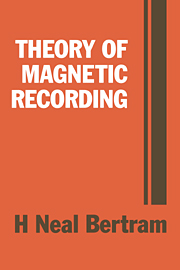Book contents
- Frontmatter
- Contents
- Preface
- 1 Overview
- 2 Review of magnetostatic fields
- 3 Inductive head fields
- 4 Medium magnetic fields
- 5 Playback process: Part 1 – General concepts and single transitions
- 6 Playback process: Part 2 – Multiple transitions
- 7 Magnetoresistive heads
- 8 Record process: Part 1 – Transition models
- 9 Record process: Part 2 – Non-linearities and overwrite
- 10 Medium noise mechanisms: Part 1 – General concepts, modulation noise
- 11 Medium noise mechanisms: Part 2 – Particulate noise
- 12 Medium noise mechanisms: Part 3 – Transition noise
- References and bibliography
- Index
9 - Record process: Part 2 – Non-linearities and overwrite
Published online by Cambridge University Press: 02 February 2010
- Frontmatter
- Contents
- Preface
- 1 Overview
- 2 Review of magnetostatic fields
- 3 Inductive head fields
- 4 Medium magnetic fields
- 5 Playback process: Part 1 – General concepts and single transitions
- 6 Playback process: Part 2 – Multiple transitions
- 7 Magnetoresistive heads
- 8 Record process: Part 1 – Transition models
- 9 Record process: Part 2 – Non-linearities and overwrite
- 10 Medium noise mechanisms: Part 1 – General concepts, modulation noise
- 11 Medium noise mechanisms: Part 2 – Particulate noise
- 12 Medium noise mechanisms: Part 3 – Transition noise
- References and bibliography
- Index
Summary
Introduction
This chapter is devoted to a discussion of non-linearities and overwrite in digital magnetic recording. The magnetic recording process is inherently non-linear as discussed in Chapter 8. The term ‘non-linearity’ in magnetic recording technology refers to phenomena that cause linear superposition to be invalid. These non-linearities arise from interbit magnetostatic interactions that occur during the write process. Two essential non-linear effects occur: non-linear bit shift and high-density, non-linear amplitude loss. In this chapter the example of dibit recording is discussed to illustrate these non-linearities. In high-density digital disk and tape systems new information is written over previous data. Separate erase heads to ensure complete erase are not utilized. The overwrite process is a form of erasure, which at sufficiently high record currents is dominated by non-linear bit shift effects of the ‘hard’ and ‘easy’ transitions. A simple model of overwrite is presented that agrees well with experiment. Although numerical models may be utilized to determine these nonlinearities, simplified analytic models are presented here, except for the case of non-linear amplitude loss.
Non-linear bit shift
Non-linear bit shift occurs during the writing process. The magnetostatic fields from previously written transitions cause the location of a transition currently being written to be shifted away from that determined solely by the recording head field. These shifts depend on the data pattern as well as on the location of each transition in the sequence. The term ‘non-linear bit shift’ is utilized here to refer to shifts that occur due to previously written transitions. Shifts caused by ‘hard’ transitions, or overwrite phenomena, also affect the net bit shift, as clarified in Problem 9.6.
- Type
- Chapter
- Information
- Theory of Magnetic Recording , pp. 245 - 260Publisher: Cambridge University PressPrint publication year: 1994
- 6
- Cited by



